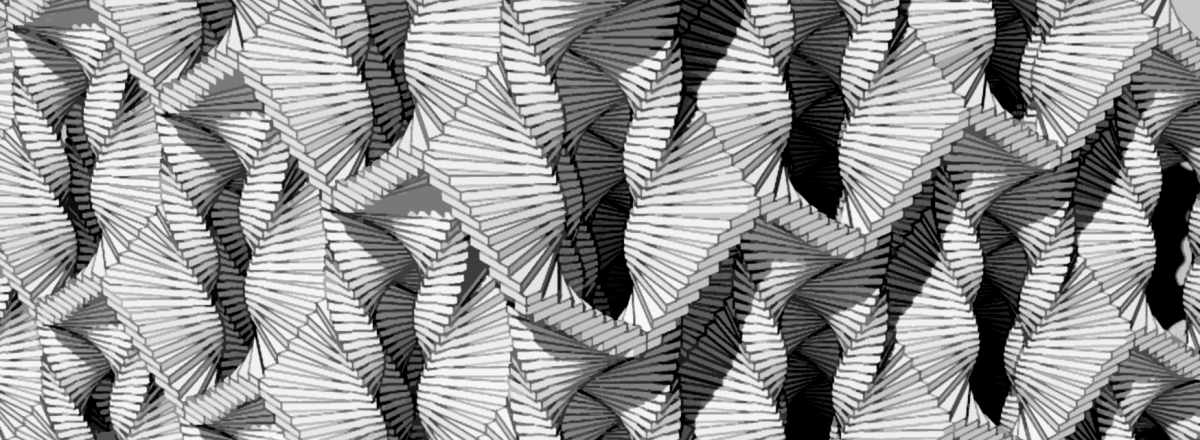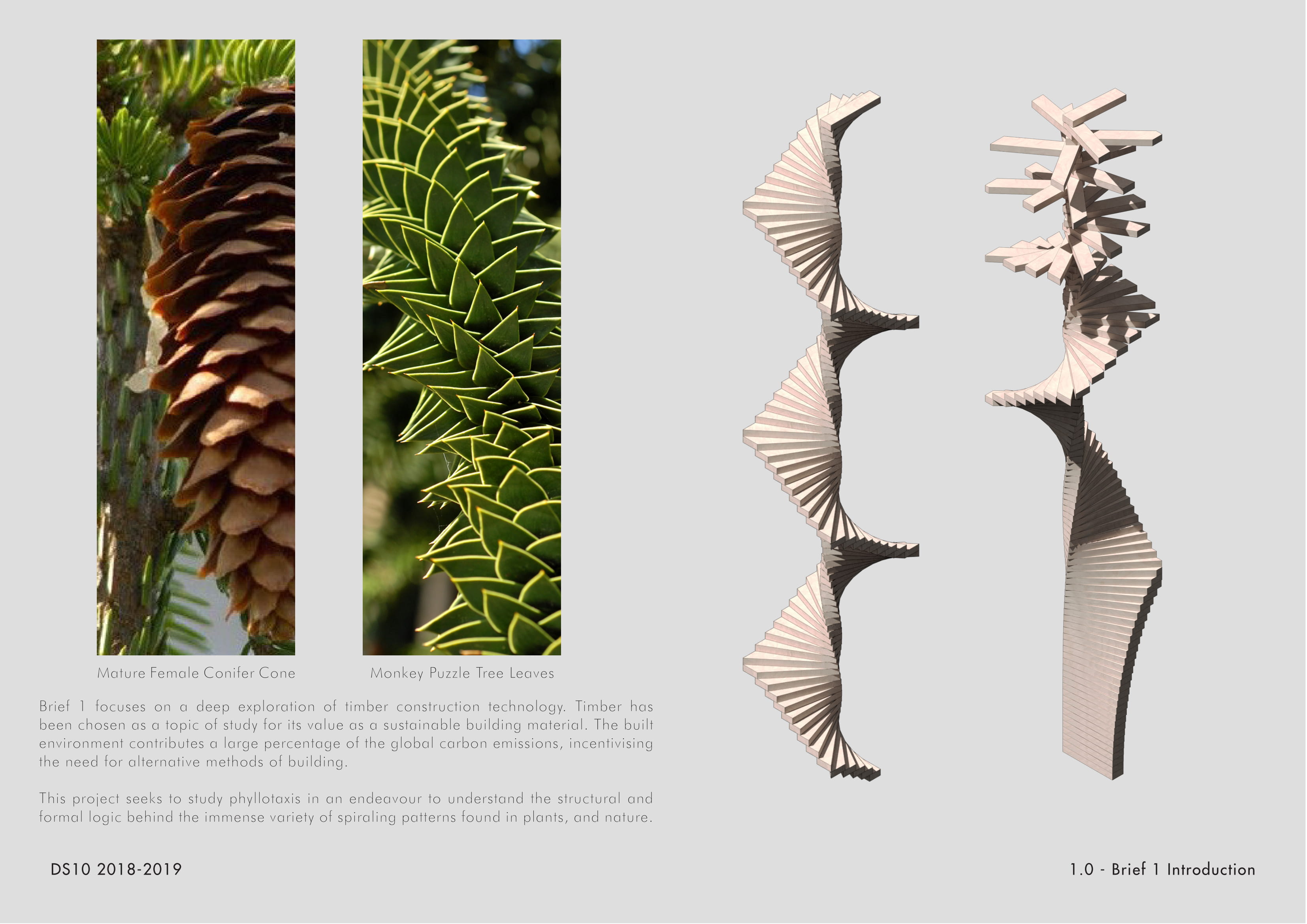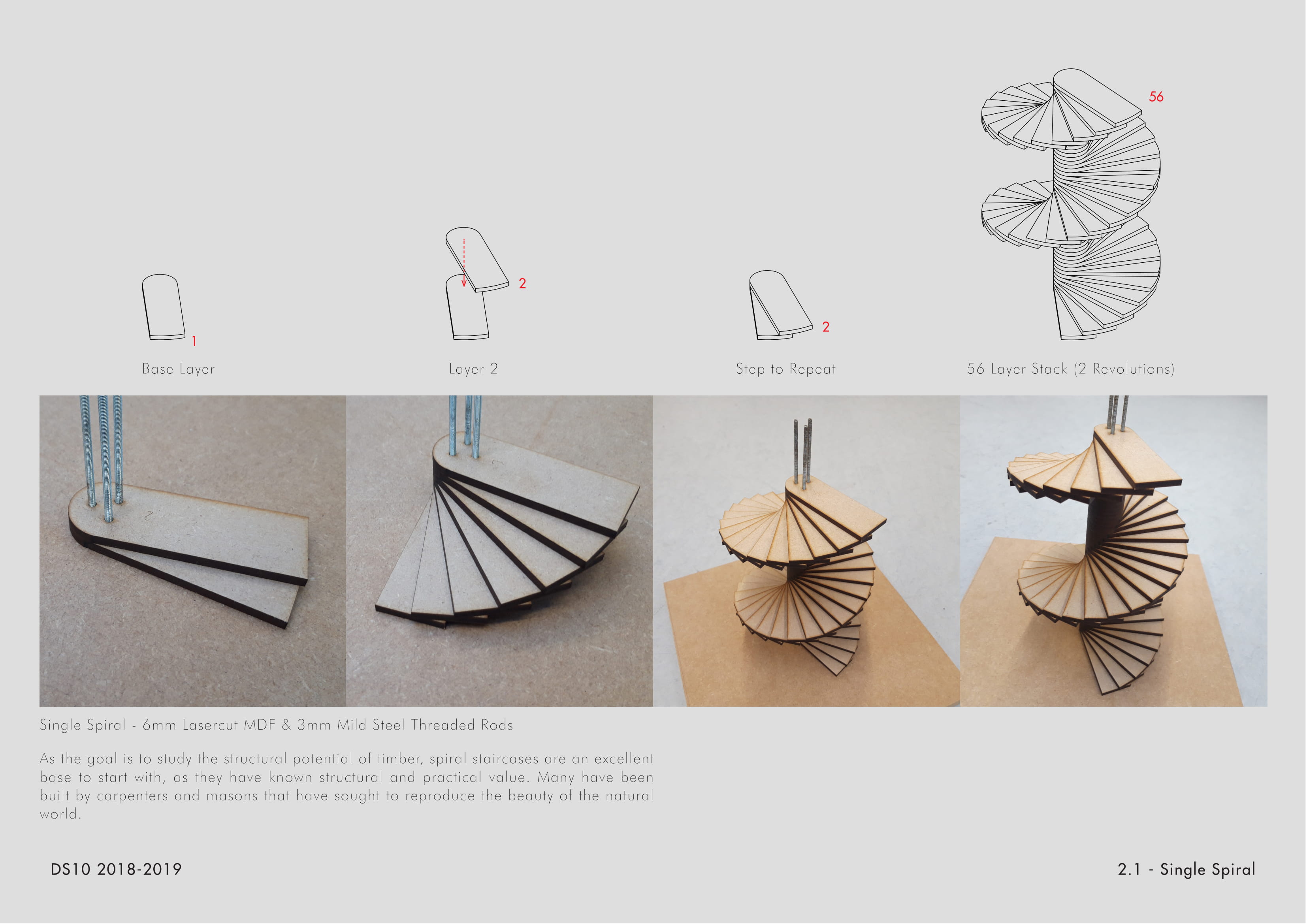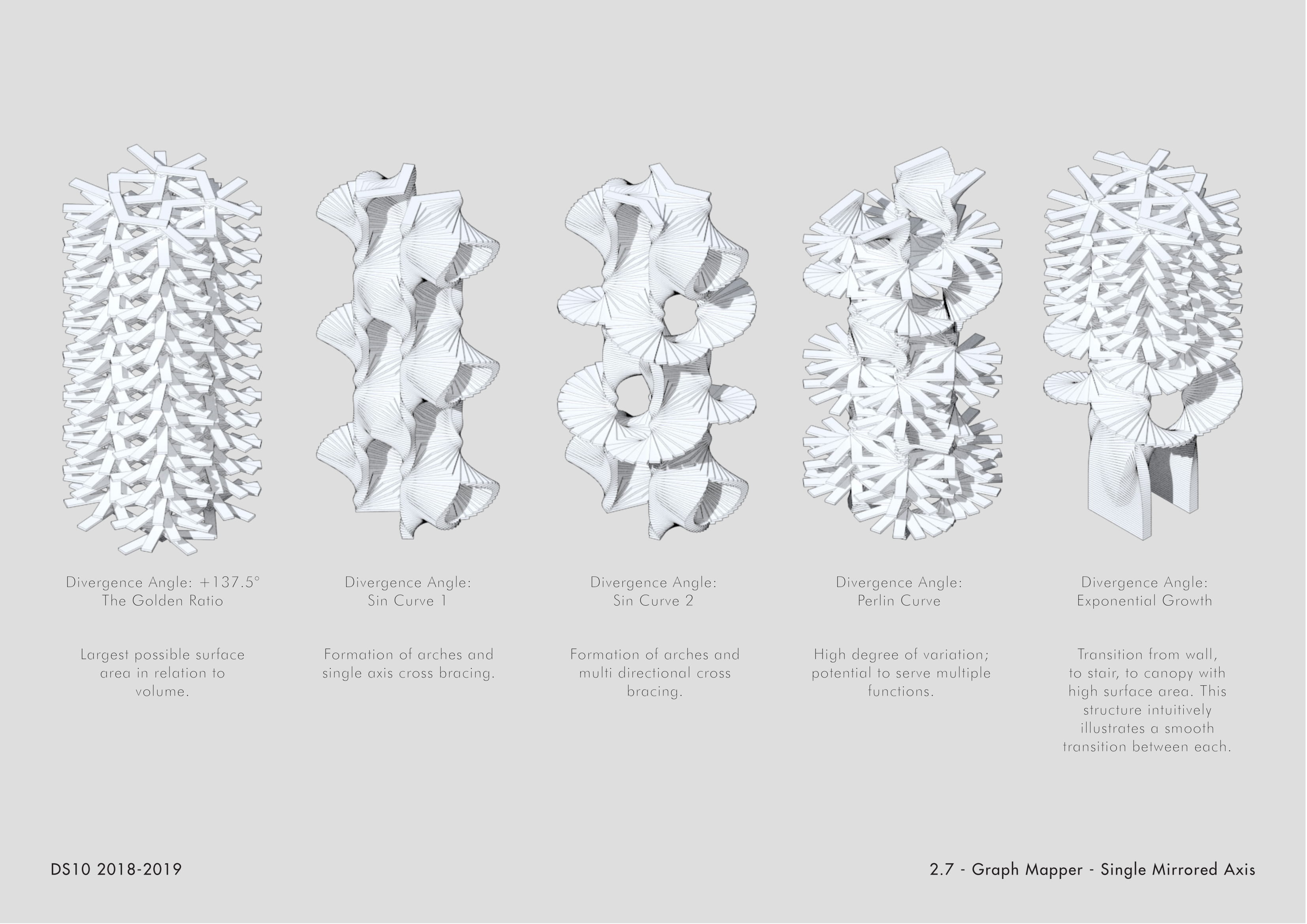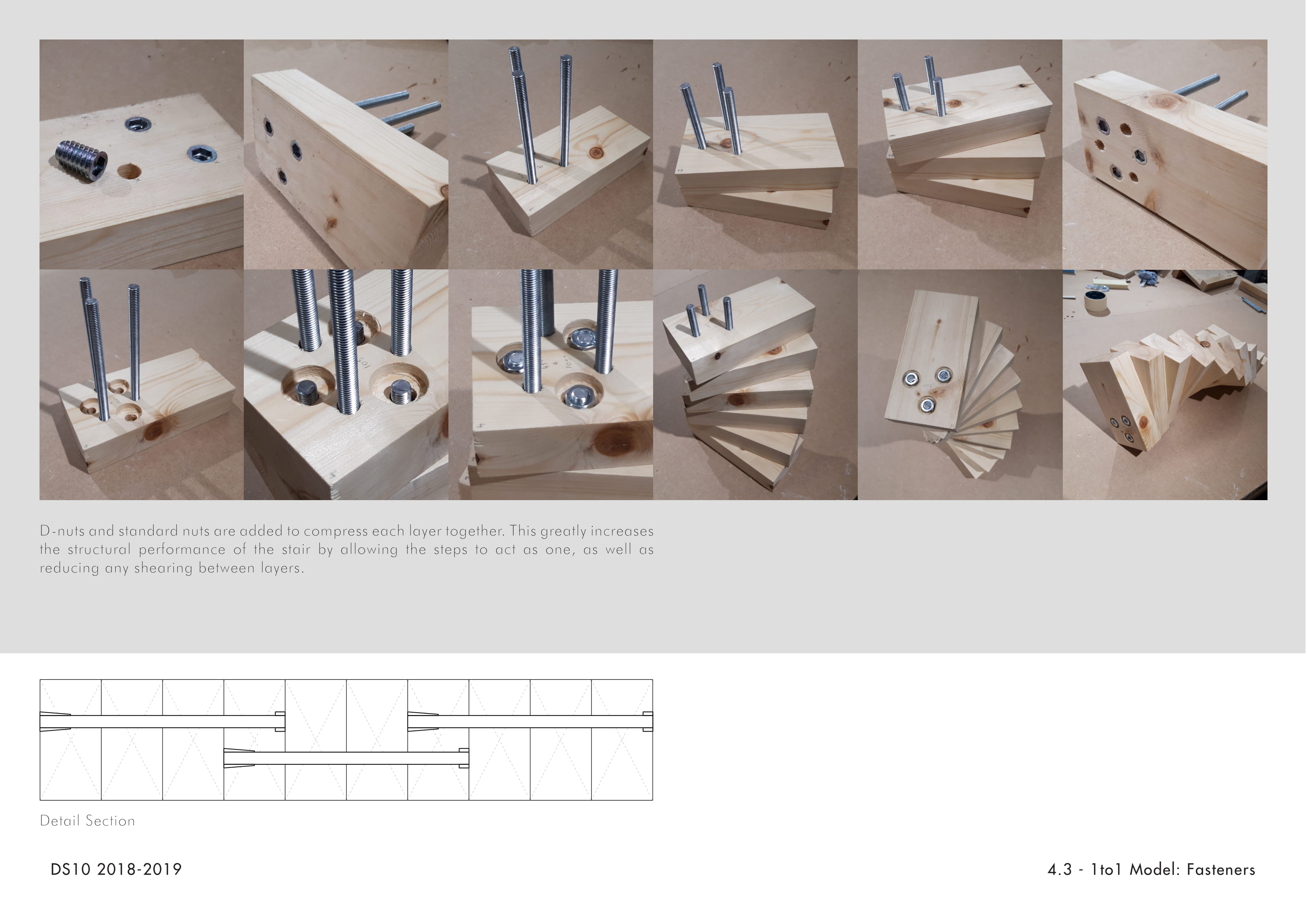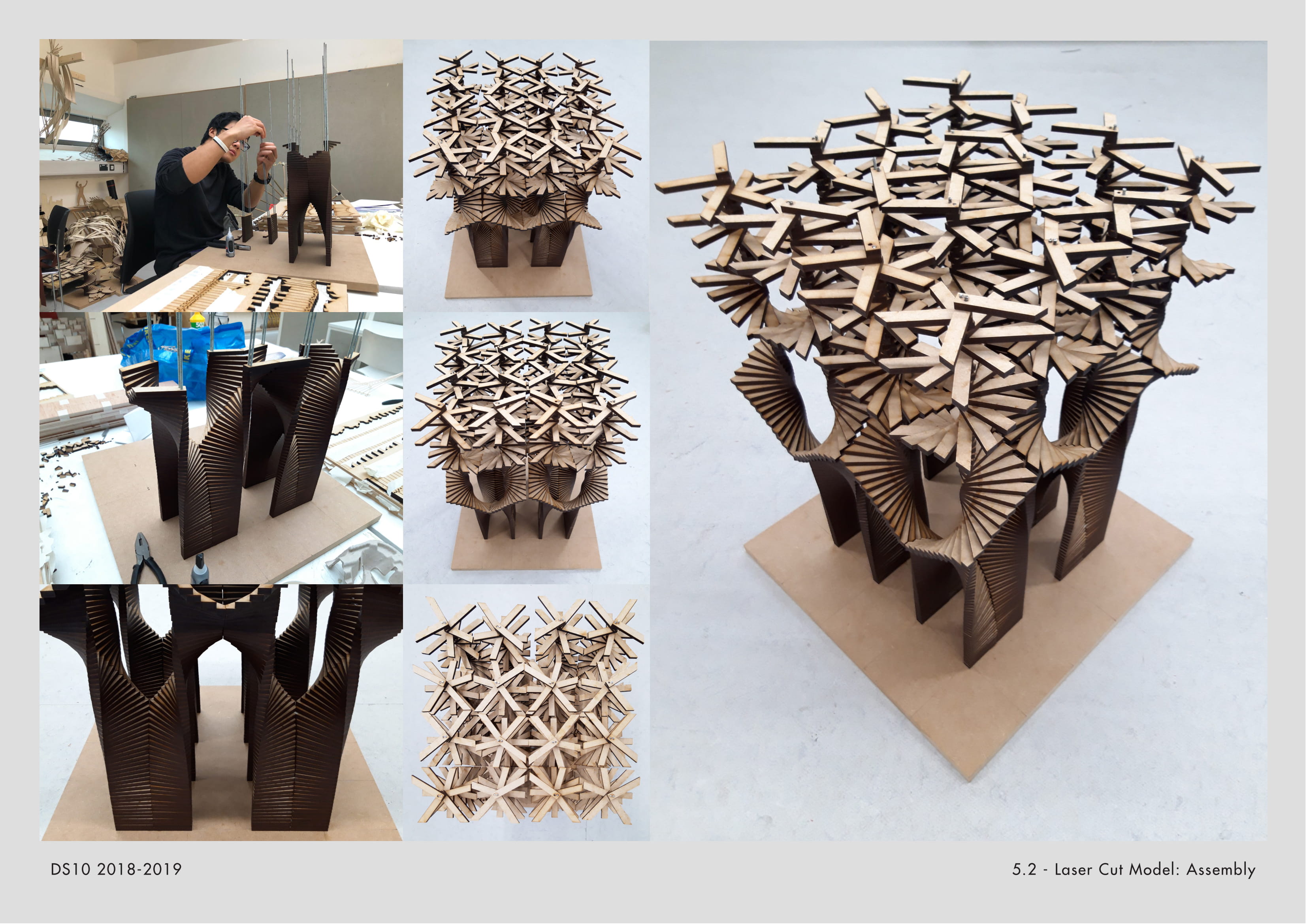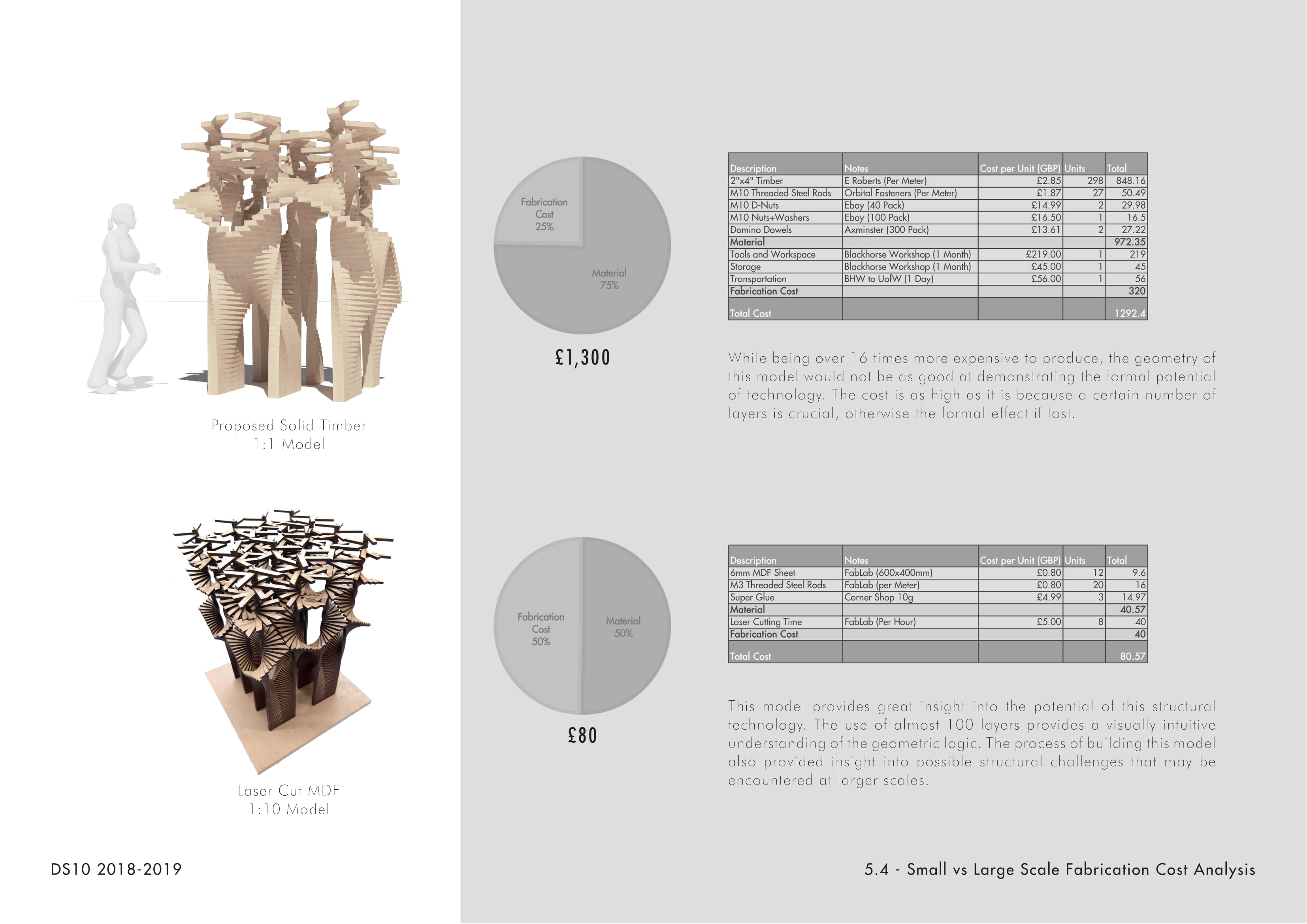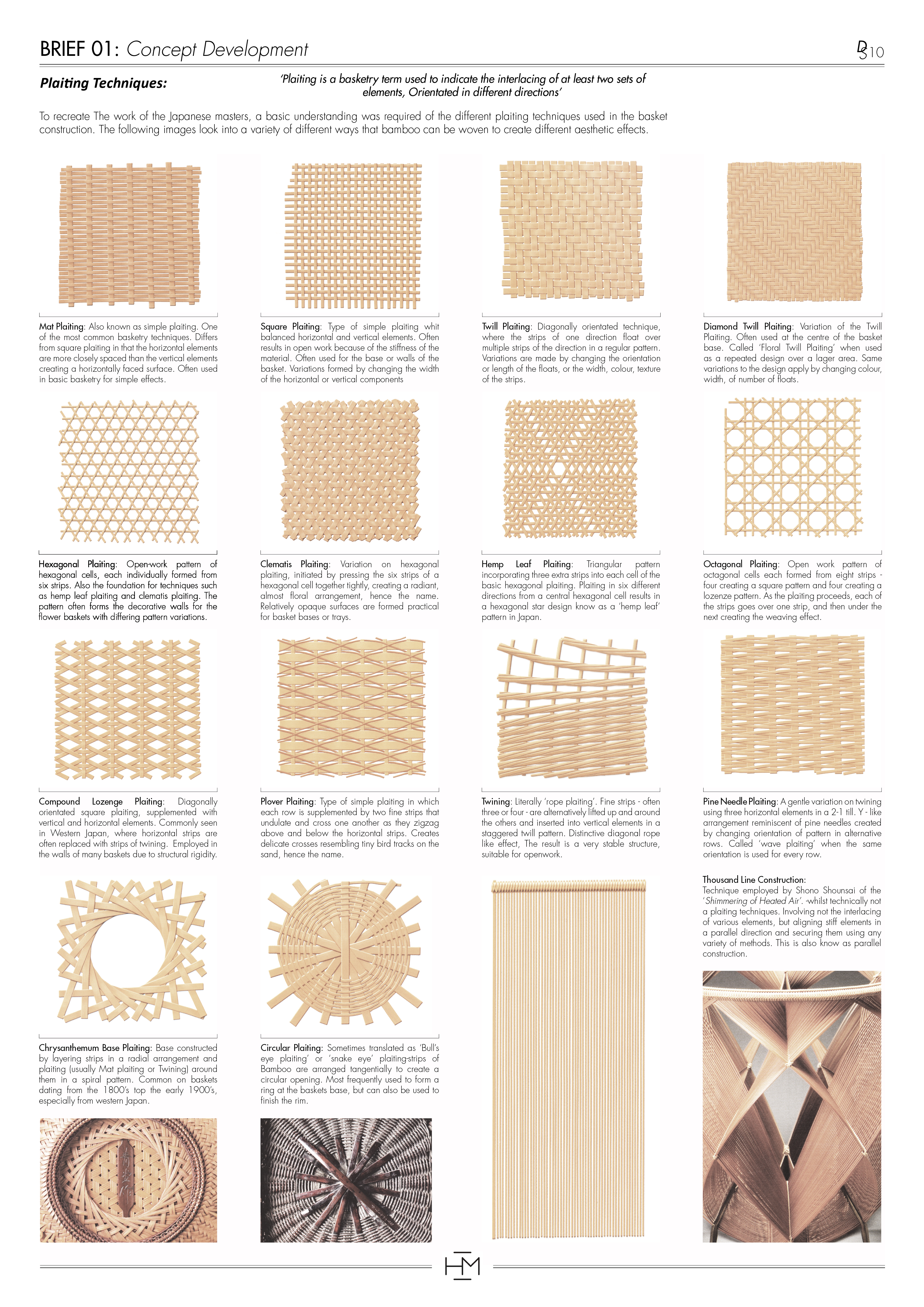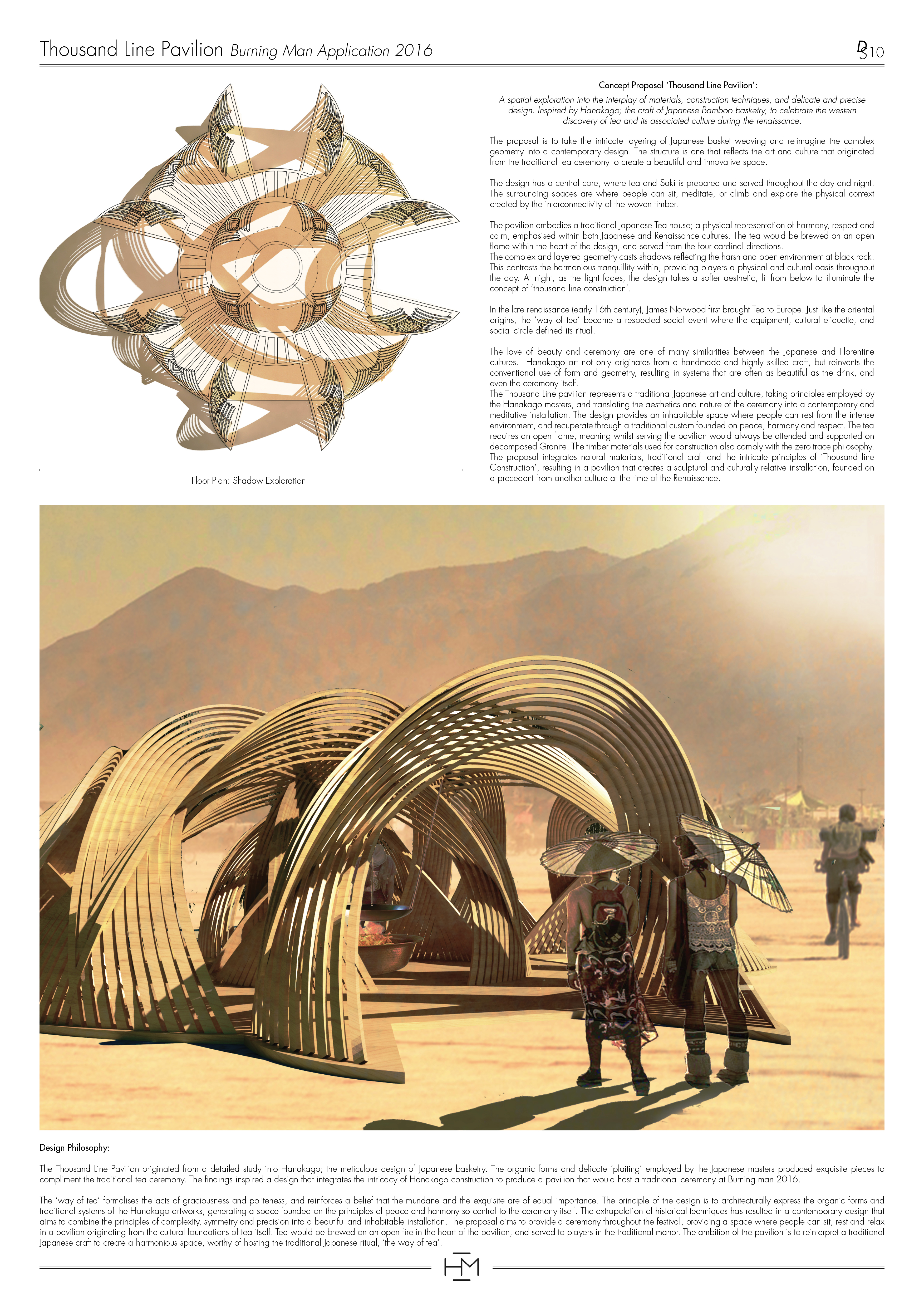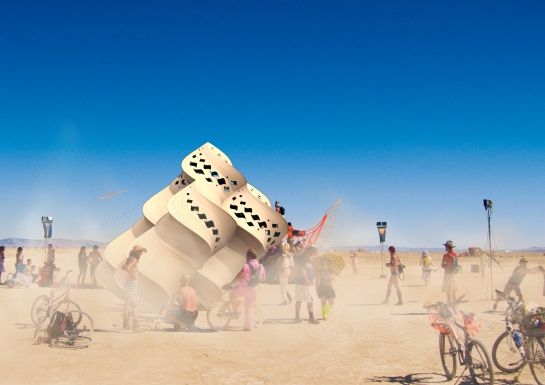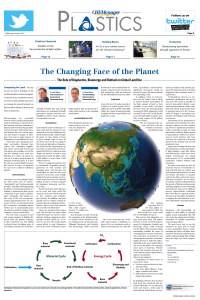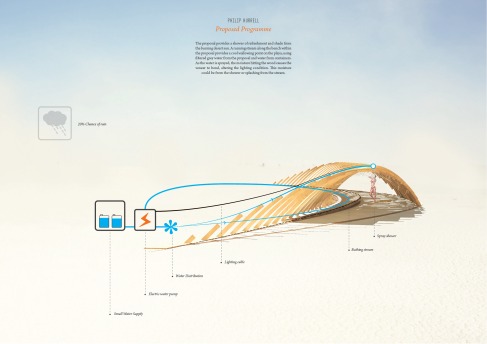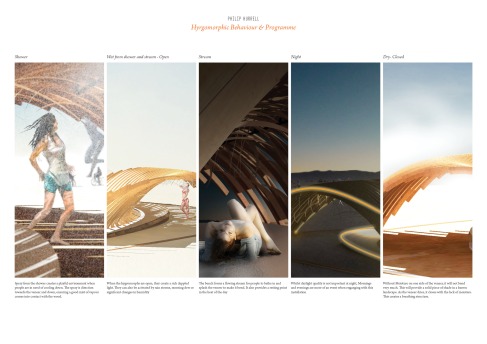Category: Material Behaviour
Triply periodic minimal surfaces _topology

Frequently occuring in nature, minimal surfaces are defined as surfaces with zero mean curvature. These surfaces originally arose as surfaces that minimized total surface area subject to some constraint. Physical models of area-minimizing minimal surfaces can be made by dipping a wire frame into a soap solution, forming a soap film, which is a minimal surface whose boundary is the wire frame.
The thin membrane that spans the wire boundary is a minimal surface of all possible surfaces that span the boundary, it is the one with minimal energy. One way to think of this “minimal energy” is that to imagine the surface as an elastic rubber membrane: the minimal shape is the one that in which the rubber membrane is the most relaxed.
A minimal surface parametrized as x=(u,v,h(u,v)) therefore satisfies Lagrange`s equation
(1+h(v)^2)*h(uu)-2*h(u)*h(v)*h(uv)+(1+h(u)^2)*h(vv)=0
(Gray 1997, p.399)
This year`s research focuses on triply periodic minimal surfaces (TPMS). A TPMS is a type of minimal surface which is invariant under a rank-3 lattice of translations. In other words, a TPMS is a surfaces which, through mirroring and rotating in 3D space, can form an infinite labyrinth. TPMS are of particular relevance in natural sciences, having been observed in observed as biological membranes, as block copolymers, equipotential surfaces in crystals, etc.
From a mathematical standpoint, a TPMS is the most interesting type of surface, as all connected RPMS have genus >=3, and in every lattice there exist orientable embedded TPMS of every genus >=3. Embedded TPMS are orientable and divide space into disjoint sub-volumes. If they are congruent the surface is said to be a balance surface.
The first examples of TPMS were the surfaces described by Schwarz in 1865, followed by a surface described by his student Neovius in 1883. In 1970 Alan Schoen, a then NASA scientist, described 12 more TPMS, and in 1989 H. Karcher proved their existence.
The first part of my research focuses on understanding TPMS geometry using a generation method that uses a marching cubes algorithm to find the results of the implicit equtions describing each particular type of TMPS. The resulting points form a mesh that describes the geometry.
Schwartz_P surface

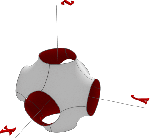
Neovius surface


Gyroid surface


Generated from mathematical equations, these diagrams show the plotting of functions with different domains. Above, the diagrams on the left illustrate the process of forming a closed TMPS, starting from a domain of 0.5, which generates an elementary cell, which is mirrored and rotate 7 times to form a closed TPMS. A closed TMPS can also be approximated by changing the domain of the function to 1.
The diagrams below show some examples generating a TMPS from a function with a domain of 2. The views are front, top and axonometric.
FRD surface
dd = 8 * Math.Cos(px) * Math.Cos(py) * Math.Cos(pz) + Math.Cos(2 * px) * Math.Cos(2 * py) * Math.Cos(2 * pz) – Math.Cos(2 * px) * Math.Cos(2 * py) – Math.Cos(2 * py) * Math.Cos(2 * pz) – Math.Cos(2 * pz) * Math.Cos(2 * px)

D Prime surface
dd = 0.5 * (Math.Sin(px) * Math.Sin(py) * Math.Sin(pz) + Math.Cos(px) * Math.Cos(py) * Math.Cos(pz)) – 0.5 * (Math.Cos(2 * px) * Math.Cos(2 * py) + Math.Cos(2 * py) * Math.Cos(2 * pz) + Math.Cos(2 * pz) * Math.Cos(2 * px)) – 0.2

FRD Prime surface
dd = 4 * Math.Cos(px) * Math.Cos(py) * Math.Cos(pz) – Math.Cos(2 * px) * Math.Cos(2 * py) – Math.Cos(2 * pz) * Math.Cos(2 * py) – Math.Cos(2 * px) * Math.Cos(2 * pz)

Double Gyroid surface
dd = 2.75 * (Math.Sin(2 * px) * Math.Sin(pz) * Math.Cos(py) + Math.Sin(2 * py) * Math.Sin(px) * Math.Cos(pz) + Math.Sin(2 * pz) * Math.Sin(py) * Math.Cos(px)) – 1 * (Math.Cos(2 * px) * Math.Cos(2 * py) + Math.Cos(2 * py) * Math.Cos(2 * pz) + Math.Cos(2 * pz) * Math.Cos(2 * px))

Gyroid surface
dd = Math.Cos(px) * Math.Sin(py) + Math.Cos(py) * Math.Sin(pz) + Math.Cos(pz) * Math.Sin(px)

This method of approximating a TPMS is high versatile, useful in understanding the geometry, offsetting the surfaces and changing the bounding box of the lattice in which the surface is generated. In other words, trimming the surface and isolating parts of the surface. However, the resulting topology is unsuitable for fabrication purposes, as the generated mesh is unclean, being composed of irregular polygons consisting of triangulations, quads and hexagons.
The following diagrams show the mesh topology for a Gyroid surface, offset studies and trimming studies.




For fabrication purposes, my proposed method for computationally simulating a TPMS is derived from discrete differential geometry, relying on the use of Kangaroo Physics, a Grasshopper plugin for modeling tensile membranes. Bearing in mind that a TPMS has 6 edge conditions, a planar hexagonal mesh is placed within the space defined by a certain TPMS`s edge conditions. The edge conditions are interpreted as Nurbs curves. Constructed from 6 predefined faces, the initial planar hexagonal mesh, together with the curves defining the surface boundaries are split into the same number of subdivisions. The subdivision algorithm used on the mesh is WeaveBird`s triangular subdivision. The points resulted from the curve division are ordered so that they match the subdivided mesh`s edges, or its naked vertices. The naked vertices are then moved in the corresponding points on the curve, resulting in a new mesh describing a triply periodic surface, but not a minimal one. From this point, Kangaroo Physics is used to find the minimal surface for the given mesh parameters, resulting in a TPMS.
Sequential diagram showing the generation of a Schwartz_P surfaces using the above method.

A Gyroid surface approximated with the above method


This approach towards approximating a TPMS leads to a study in the change of boundary conditions, gaining control over the geometry. The examples below present various gyroid distorsions generated by changing the boundary conditions.



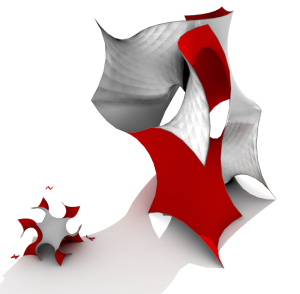
Being able to control the boundary conditions defining a gyroid, or any TPMS, opens up to form optimization through genetic algorithms. Here, various curvatures for the edge conditions have been tested with regards to solar gain, using Galapagos for Grasshopper.




The following examples show some patterns generated by different topologies of the starting mesh.










Thousand Line Construction
Thousand Line Construction :
Hamish Macpherson
A spatial exploration into the interplay of materials, construction techniques, and delicate and precise design.
Inspired by Hanakago; the craft of Japanese Bamboo basketry, to celebrate the western discovery of tea and its associated culture during the renaissance.



Vulcan’s Flame
A geometric wall of fire burning on the sands of the Black Rock Desert. This immobile blaze stands as an edifice to Burning Man’s original figurehead. A burning yet fireless wall of plywood and acetate that can be encountered, entered and sheltered in.
This sculpture stands as an abstract image of flames sent by Vulcan the Roman God of fire, an emblem of the festival’s name. Created from a series of plywood shapes and acrylic, Vulcan’s Flame is a blazing wall of light and colour. The structure is created to both imitate and juxtapose chemical fire, sharing real fires beauty but opposing its destructive tendencies. The sculpture is designed as a wall of shelter, behind which burners can be shielded from the desert’s unforgiving sun.
Born from Ancient Egyptian ‘Cairo tiling’, the sculpture is created from morphing polyhedra. The lowest section of the fire is created from cubes which gradually deform into rhombic dodecahedrons – a cubist interpretation of a flames movement. Internally every shape is painted to mimic fire’s bright hues and coloured acetate panels within the wall will project red and yellow tones onto the surrounding desert floor. At night internal spotlights will illuminate the entire structure, creating a glowing inferno of colour. These lights will flicker to create the illusion of movement.
Visually the main structure consists of three main forms;
- The outer zone: the sparse cubic section of the sculpture, representing the hottest part of a flame, the region of complete combustion
- The middle zone: this is the central area in which the cubic deformation begins to occur.
- The inner zone: this is the coolest space, the most densely packed red area of the sculpture. Burners can crawl into this space – sheltered by four layers of dodecahedrons.
Physical Description:
Vulcan’s Flame is a long, low plywood structure, the installation is the geometric interpretation of a flame, a curving sculpture of deforming polyhedral that slowly transform from a cube to a rhombic dodecahedron. The sculpture is created from 55 plywood polyhedra constructed from hand cut plywood boards and secured with cable ties. Internally each shape is painted using natural, organic paints, as the shapes change their internal colour alters from yellow to red. Coloured acetate panels in the uppermost faces of each shape will mirror the shapes internal hue, these panels will allow sunlight through during the day casting beautiful coloured shadows on the desert floor. At night the sculpture will be lit internally with fluctuating spot lights, this will create the illusion of flickering movement. The acetate panels will be secured with nails.
The structure sits on a base of 23 plywood shapes, secured to the ground with rebar stakes. The sculpture is very stable as the base is the widest section, the rest of the sculpture tapers away towards the top. Each new shape rest on the 4 corners of the shapes below, bolted through the vertices and then secured with rope. The final and highest rhombic dodecahedron is stabilised with a steel column. The highest point on the entire structure is just over 11 feet above ground level and consists of 4 stacked shapes. A full sized version of one of the shapes has already been constructed and load tested confirming that it can support human weight, all of the cable ties securing the structure will be meticulously rubbed down to ensure they are not sharp.
The sculpture curves in a gentle arc – creating a central area of shelter from the wind and sun. At ground level Burners can crawl inside the structure and rest in it’s shady, tinted interior.
Inspired by previous research of pyritohedrons, these structures are an addition to a series of other models based on polyhedral deformation. Previous models have experimented with density, altering colour and infill panels.
Fiery Lantern
“Fiery Lanterns” is an expression of sustainability and simplicity, in a modern consumerist world when simple ancient systems are taken for granted. In the theme “Caravansary”, the installation aims to initiate a cultural exchange, encasing Burners and creating crossroads to connect world’s neighbourhoods. The installation shows the possibilities of analysing natural mathematical systems, which we commonly interact with in everyday life and reinterpreting them. Research to produce “Fiery Lanterns”, has allowed detailed prototyping of bending timber to create a memory structure. Testing it to destruction and pushing the understanding of its properties, utilising its strengths and minimalising its weaknesses.
The installation takes inspiration from natural repeating phyllotaxis spirals in sunflower heads. These interconnecting spirals are orientated by the mathematical rules of the golden ratio and governed by successive Fibonacci numbers, to create beautiful majestic forms. This is translated into the identical panels of the “Fiery Lantern”, simply stitched together; they twist and turn to create an ornate case to protect the flames within. This is communicated to the Burner by the symmetry in the design and how you interact with the lanterns. It gives a modern definition of the possibilities of encasement in wood and builds on what is capable using this system.
“Fiery Lanterns” are made from four identical stitched panels, which are rotated around each lantern’s central axis. The curves of the panels are all related to each other, allowing the lanterns to be tightly packed together. The exterior form purposely deceives the Burner, enticing them to explore within and encase themselves in the individual lanterns. The internal maze encourages the exchange and interaction of cultural ideas, to proceed to the pinnacle shimmering lantern.
The lanterns are driven into the ground, creating a solid structure, with no predefined front, back or side. The hidden internal entrance, allows Burners to search for the center of the “Fiery Lantern”, crawling or relaxing in the shade, connecting with the playa so as to reach encasement. It does not create barriers in the vast landscape of the Black Rock City, but the lantern’s openings invite a glimpse of the vibrant treasure within. The Burner views the internal surprise and is encouraged to have their own sensory journey, weaving through the individual lanterns, taking their own experience and creating their personal connections. The pinnacle lantern, offers a perspective view over the playa, allowing the Burner reflection on the path below.
Fiery Lanterns spirals out of the harsh compact playa ground in the vast expanse of Black Rock City, surrounded by Burners and art installations. Burners can interact with the installation, explore the individual lanterns and find the Burners encased within. They seek to reach the pinnacle lantern, for reflection on the way forward. As the sun sets at the end of the festival, the internal flames in the lantern will be extinguished and the installation burnt.
The installation has evolved through a detailed research into the natural repeating phsyllotaxis spirals in sunflower heads. It is interesting to consider how each spiral is interconnected with the next and governed by the same set of mathematical rules, however changing the parameters changes the resultant architectural form. This is translated in the individuality of the Burning Man experience, the internal connections between the lanterns, offer the same experience, but generate differing personalised interactions with the Burners encased within.
Physical modelling demonstrated how the related curves in the components, allows for the lanterns to be tightly packed together. The repeating panels and simplistic design principle, enable open resourcing meaning once the Fiery Lanterns’ flame has been extinguished it can be resurrected at various scales, using the same laser cutting templates.
The scale of the lanterns, allows each component to be cut from a single sheet for plywood, meaning only repeating vertical seams are expressed. Each lantern is an intimate encasing, fitting one or two Burners. Burners must transverse through each lantern in order to reach the pinnacle, it encourages travellers to cross paths and initiate a cultural exchange. 12mm birch faced plywood is used, as the thickness allows the material to be flexible, but also retains its strength. The plywood becomes malleable once soaked in warm water and can be stitched into the panels. The assembly process and onsite installation is simple and uses minimal bolts.
The flame cannot be lit in the lantern until the ornate encasement has been completed. Construction commences through ground anchoring the secluded base lanterns. Soaking and stitching the panels for the internal maze, allows the form to evolve to enable the crowning of the pinnacle lantern. Once dry the Fiery Lantern is complete, the wood’s structural capabilities and sturdiness return, the flame can be lit and it can guide the souls of the playa.
The internal space provides a refuge in the vast expanse of the landscape, shielding from the winds and creating a portal of shade. However, it is not a solitary experience; the openings allow all Burners access to the space. You are able to see out, past or through the structure to the rest of Black Rock City.
The lack of a defined entrance means Fiery Lantern has a differing appearance from each angle. It encourages Burners to explore the proposal, to realise encasement. It draws them to the warmth and love of the flames within.
The lack of a defined entrance means Fiery Lantern has a differing appearance from each angle. It encourages Burners to explore the proposal, to realise encasement. It draws them to the warmth and love of the flames within.
Three-Dimensional Mid-Air Acoustic Manipulation
Lying somewhere between science and art, University of Tokyo scientists Yoichi Ochiai, Takayuki Hoshi and Jun Rekimoto use precision acoustics to bring the beauty of sound waves to life in three dimensions.
More information here from the University of Tokyo, Nagoya Institute of Technology

(bio)Plastic Morphologies
What if Bioplastic could be used as a green construction material ?
Plastic can acquire any shape you give it.
But what about the natural behaviour of the viscous material?
Experiments consisting in elongating the viscous material can reveal an interesting form configuration that has inherent structural properties.
The rules defining the the material configuration are then coded into a script that enables to digitally replicate the shape. The structural performace of the shape opens the opportunity for many applications.
A bridge is imagined following the same formal configuration.
Near Unison | Dan Dodds | Kinetica Art Fair 2013
Near Unison, my project exploring harmonographic traces is currently being shown at Kinetica Art Fair. The exhibition is in Ambika P3, the exhibition space attached to the University of Westminster on Marylebone Road. For more information on the exhibition, and details about tickets and opening times please visit the Kinetica Art Fair website.
The exhibit features a prototype of the interactive harmonograph swings that could form part of the larger installation proposed for Burning Man Festival, along with casts of the harmonographic traces left in sand, and photographic work documenting the process.
“The 5th Kinetica Art Fair returns February 28th – March 3rd 2013 at Ambika P3, as one of London’s annual landmark art exhibitions and a permanent fixture in the Art Fair calendar, renowned as the UK’s only art fair dedicated to kinetic, robotic, sound, light, time-based and new media art.
Kinetica is hosting the work of over 45 galleries and art organisations nationally and internationally, with representatives from UK, France, Russia, USA, Poland, Holland, Spain, Italy, Hungary, Indonesia and Japan, collectively showing over 400 works of art.
A huge interactive light sculpture from Dutch artist Titia Ex will greet visitors as they enter the impressive Ambika P3 venue, and giant 3D sculptures from Holotronica will hover above the main space of the Fair. Other highlights include an exoskeleton hybrid of mananimal-machine by Christiann Zwanniken; a giant three dimensional zoetrope by Greg Barsamian; and a life-size ‘Galloping Horse’ made of light by Remi Brun”
Kinetica Art Fair Press Release
The Role of Bioplastics, Bioenergy and Biofuels in Global Land Use
This is a very interesting article about the increasing role of Bioplastics and Bioenergy and its effects on the global land use.
The Role of Bioplastics- Bioenergy and Biofuels in Global Land Use
The article was published in March 2012
FREEMETRY – Hygroscopic Behaviour in the Desert
Freemetry is a response to the contrast between geometry and freedom at the Burning Man festival in Nevada. The strong distinction between layout symmetry and strong guidelines, with the emphasis on radical self expression is fascinating. Something this proposal seeks to express by exploring the self-organising, Hygroscopic behaviour of wood veneer within a symmetrical framework. Freemetry provides a destination on the open expanse of the nevada desert in the form of a refreshing shower and shade in a harsh exposed environment.
The orientation of the proposal tries to maximise the amount of shade throughout the day, whilst providing a refreshing shower and bathing stream to cool down in. The water used on the proposal sprays onto the veneer to affect change, whilst dripping onto users. The resulting light quality changes throughout the day with use and will also be activated by large changes in humidity or rainfall.
Build Sequence above.
The work of Richard Serra has had a profound impact on my perception of space. When approaching the design, I asked myself how I could introduce elements of Serra’s approach in creating a passageway. Where a person’s perception of that space can change as they move through it. Initially I designed a proposal on a larger scale to Freemetry, with similar components and programmatic elements, shown below.
Further development and scale testing of this proposal highlighted a few key design and fabrication issues. The image below shows the component that was made to a scale of 1:2. The design issues meant it was unable to stand on its own. The issues are highlighted in the following images and initiated a re-design to ensure the proposal actually works.

